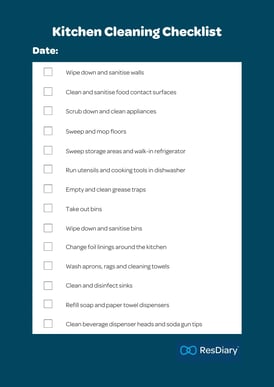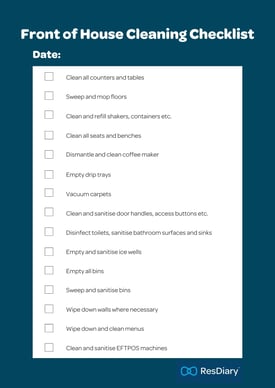At all times, a restaurant must uphold a certain level of cleanliness. This is both for presentation purposes and food safety regulations, which are enforced across Australia and New Zealand in all food businesses.
It may seem daunting at times to keep both the front and back of house clean to professional standards. A helpful restaurant cleaning checklist can help keep you and your staff on task every day. This checklist extends beyond opening and closing tasks, helping your business remain spotless throughout the day and well into the night.
We’ve stepped up to provide a daily restaurant cleaning checklist tailored to each section of a restaurant, covering even the smallest of cleaning tasks. After all, every step is crucial to maintaining a clean and reputable food business.
The Importance of Regular Restaurant Cleaning
So, why is restaurant cleaning so important? Why must all food businesses guarantee that their food is prepared correctly and their equipment is cleaned to a specific degree?
Beyond the need to look professional and indicate dedication to your image amongst customers, restaurant cleanliness is necessary for health and food safety. Every food establishment across Australia must adhere to the Food Standards Code, which encompasses key practices such as food preparation, hygiene practices by staff, and how sufficient levels of cleanliness can be ensured.
Similarly, each New Zealand food business must follow legislation to ensure that health and safety measures are in place.
Restaurants across Australia are regularly inspected, usually once a year, by council environmental health officers to assess current levels of health and food safety. New Zealand businesses may also be visited by representatives from the Ministry of Primary Industries in the case of suspected food safety concerns.
These official figures ensure that food businesses are following regulations such as:
- Temperature control around food
- Personal hygiene levels of both kitchen and front of house staff
- Food labelling
- Pest control
- Maintenance of premises
- General cleanliness of key areas such as food prep equipment and surfaces
- Cleaning supplies in use
- And so much more
Businesses that minimally fail an inspection are often first left with an Improvement Notice, listing out what areas need to be addressed. More serious cases will face monetary penalties starting at $440. The charges are determined on an individual basis, often costing more for franchises. However, each penalty for a business is determined by local jurisdiction, meaning that the process varies across Australia and New Zealand.
Failure to improve the cleanliness of a restaurant can lead to more serious actions, such as prosecution, seizure of property, or a prohibition order.
Hence, it is best to ensure your restaurant remains spotless at all times. This is important not just for the success of your business, but also to ensure the safety of your customers and their comfort.
Handling customer complaints may be a daily part of the restaurant business, but many are easily preventable through care and dedication, such as regular cleaning.
You are also more likely to achieve repeat customers and higher revenue if your business is visually appealing and upholds a high level of cleanliness.
Restaurant Kitchen Cleaning Checklist
The back of house in a restaurant is where the food preparation, storage, and cooking occurs. Thus, it is one of the most crucial areas to keep clean and sanitise on a regular basis. Without proper cleaning procedures in place, food can become contaminated and lead to customers developing illnesses like food poisoning.
The following restaurant kitchen cleaning checklist provides a guide for what cleaning tasks need to be completed on a daily, weekly, and monthly schedule. These tasks encompass key areas such as sanitisation, cooking equipment cleaning, and how to ensure thorough cleaning of areas that are often forgotten to maintain food safety standards.
Daily
Some kitchen cleaning tasks must be completed every day to ensure food contact surfaces and kitchen equipment remain sanitary. This ensures no potentially dangerous foods are being served in the restaurant, and that the kitchen remains accessible at all times.
Daily tasks that kitchen staff have to complete include:
- Wiping down and sanitising all walls to prevent food residue or grease buildup
- Cleaning and sanitising food contact surfaces like cutting boards, countertops, etc
- Scrubbing down and cleaning any kitchen appliances, such as stove tops, ranges, grills, toasters, microwaves, etc
- Sweep and mop floors
- Sweep storage areas and walk-in refrigerator space if applicable
- Run all utensils and cooking tools through the dishwasher
- Empty and clean grease traps
- Take out rubbish and recycling bins
- Wipe down and sanitise rubbish and recycling bins
- Change foil lining on the tops of ranges, grills, and flattops if in use
- Wash all aprons, rags, and cleaning towels in the washing machine
- Clean and disinfect the sinks
- Refill soap and paper towel dispensers
- Clean beverage dispenser heads and soft drink gun tips
Weekly
Some tasks in the kitchen generally only need to be done on a weekly basis for general upkeep and cleanliness. These tasks include:
- Scrub clean ovens
- Boil out the deep fryer
- Clean lime from sinks and faucets
- Clear out floor drains with drain cleaner
- Sanitise walk-in refrigerator and freezer, including their shelves and walls
- Clean floor mats
- Empty the outdoor rubbish bins at least twice a week
Monthly
The monthly cleaning tasks for the kitchen area of a restaurant help maintain overall cleanliness levels, while also ensuring all equipment and appliances operate optimally. This includes the following monthly tasks:
- Wiping down all walls and the ceiling to prevent buildup of grease and food
- Clean behind the hot line (ovens, stoves, deep fryers, etc)
- Empty grease traps that do not require daily cleaning
- Empty, clean, and sanitise the ice machine (usually only required every 6 months)
- Clean out vent hoods every few months or when build-up is obvious
- Replace pest traps
- Clean the refrigerator coils
Restaurant Front-of-House Cleaning Checklist
When it comes to restaurant cleaning, the kitchen may be a focal point of food safety however, the front of house is where customers spend their time and make first impressions. They expect to spend their time dining in an establishment that is both clean and inviting. When a restaurant is visibly dirty to the public, they are less likely to become customers. In time, this can hurt your venue's bottom line and make it difficult to create a crowd of loyal patrons.
Fortunately, the following restaurant cleaning schedule checklist can guide you through the daily, weekly, and monthly tasks that are guaranteed to keep your front of house clean.
Daily
To help maintain appearances and deliver positive customer experiences, front of house staff should perform the following cleaning tasks daily:
- Clean all counters and tabletops after use and at the end of the night to remove food residue
- Sweep and mop floors throughout the entire restaurant
- Clean and refill salt and pepper shakers, sugar containers, utensil and napkin dispensers, and any other condiments
- Clean all seats and benches
- Dismantle and clean any coffee makers
- Empty drip trays
- Vacuum carpets
- Clean and sanitise door handles, access buttons, elevator buttons, and railings
- Disinfect toilets
- Sanitise bathroom surfaces and sinks
- Empty and sanitise ice wells
- Empty bathroom garbage and feminine hygiene bins
- Wipe down walls when necessary
- Empty recycling and garbage bins
- Perform a sweep and sanitisation of garbage and recycling bins
- Wipe down and clean menus
- Clean and sanitise EFTPOS machines
Weekly
When it comes to weekly tasks in the restaurant cleaning checklist, front of house staff should perform the following:
- Dust light fixtures clean
- Wipe down and buff out glass windows and doors
- Tend to any live plants and water them
- Vacuum any harder-to-reach areas
- Clean and flush out keg lines at the bar
- Dust and wipe down bottles and shelves behind the bar
Monthly
The front of house monthly restaurant cleaning checklist should include the following tasks for any establishment:
- Dust any items hanging on the walls, such as art or decorations
- Clean all walls
- Knock any cobwebs off the ceiling
- Check the furniture, carpet, and curtains for any damage to be repaired
Tips For Maintaining a Clean Restaurant
Having a restaurant cleaning checklist for both the front and back of house allows employees to know exactly what tasks are required on regular schedules. These clear instructions ensure that your restaurant is compliant with local health codes and appealing to customers. The checklist aids in the improvement of restaurant operations, streamlining the cleaning process.
However, you can elevate your restaurant cleaning abilities to whole new levels by following these simple yet helpful tips:
Restaurant Cleaning Tip 1: Prevent Foodborne Illnesses First
Regular restaurant cleaning tasks that focus on appearance and front of house are crucial for business. However, safe preparation, storage, and cooking of food should come first to prevent any illnesses in customers.
Most foodborne illnesses are brought about by bacteria, viruses, or unhealthy chemical substances in contaminated foods. The severity of these illnesses vary, but at no point should a restaurant be causing a customer discomfort or sickness from their food. Preventing contamination is the best way to achieve this, which requires strict adherence to food safety.
Common causes of food contamination that are to be avoided include:
- Incorrect storage of food items
- Improper hygiene practices, such as staff not washing hands
- Pests
- Improper cleaning of cooking equipment and eating utensils
- Cross-contamination, especially on food prep surfaces
- Staff coming in sick then coughing and sneezing when preparing food
Restaurant Cleaning Tip 2: Train Your Staff in Health & Food Safety
Health and food safety issues should not be taken lightly in the food industry, especially since food often passes through multiple hands before reaching the customer. Thus, all employees, not just those in the kitchen making food, should be trained in health and food safety.
Take the time to train all staff on proper hygiene, safe food practices, and cleanliness expectations. This kind of training ensures every customer has a safe and enjoyable dining experience. Food presentation may be crucial to appeal to customers, but this kind of dedication should also be extended to other aspects of the venue.
Regular refreshment of this training should also be done to ensure restaurant upkeep remains optimal. You can help your staff by:
- Placing a restaurant cleaning checklist in visible areas to follow a schedule
- Check over staff cleaning behaviours to ensure they align with health department standards
- Acknowledge excellent cleaning habits
- Model optimal cleaning skills to showcase restaurant standards to staff
- Share relevant training videos with staff that focus on cleaning
Restaurant Cleaning Tip 3: Regularly Check Your Health Department's Guidelines
Your local health department is the facility that will inspect your restaurant and determine its health and safety levels. In New Zealand, there are four key health districts to choose from. The district your restaurant is located in will oversee your inspection. For Australians, the process is slightly different due to each state and territory overseeing their own health districts and local departments. Thus, you can get in contact with your state or territory health departments to learn who your local department is.
Inspections that find venues lacking in hygiene or safe practices have the power to impart warnings that can lead to monetary fines or prosecution. Customers are not going to come to a restaurant that has been identified as a health and food safety hazard, so your bottom line can be affected by poor cleaning habits.
Get ahead of the game by regularly checking on your local health department's health and food safety guidelines. Further information on who you can contact across Australia and New Zealand is available here.
Restaurant cleaning checklists can be tailored to successfully follow each guideline, keeping your restaurant clean and an exemplary example of sanitisation. When inspection day comes around, your restaurant is sure to pass with flying colours.
Restaurant Cleaning Tip 4: Eradicate Pests
Keep your restaurant pest-free to prevent the spread of bad bacteria and negative reviews from customers. You may be dealing with insects or rodents if you notice signs like:
- Droppings
- Small piles of dirt from ant movements
- The sounds of scratching, movement, or chittering in the walls
- Unusual odours from dead rodents or large cockroach colonies
- Flying insects around food storage and preparation areas
- Chewed-up cardboard or plastic
- Shredded materials for nesting
While it is always best to call in a professional when faced with a pest problem, you can prevent the issue by following a restaurant cleaning checklist such as this one. Additional practices that can help prevent pests include:
- Storing food correctly in airtight containers
- Cleaning equipment immediately after use
- Wiping up all food residue
- Not allowing the buildup of grease or dirt on food-contact surfaces
- Capturing pests with traps
- Taking out the rubbish each day rather than letting it stay in the restaurant
Restaurant Cleaning FAQs
How Often Should Restaurant Floors Be Cleaned?
For optimal cleanliness, all restaurant floors should be swept and mopped every day. This task is usually to be completed at the end of every shift or when messes become noticeable.
What Should Be Cleaned Daily in a Restaurant?
What Should Be Cleaned Daily in a Restaurant?
There are certain areas and features in a restaurant that should be cleaned daily. These include:
- Floors, tables, counters, and seats
- Bathrooms
- Menus
- Cooking equipment, including appliances
- Eating utensils
- Sinks
- Clothing and cloths used that day
- Bins
How Often Should You Change Mop Heads in a Restaurant?
Cleaning supplies and equipment may help you keep your restaurant tidy, but that does not mean they do not eventually become dirty themselves. Mop heads are a key example of this, requiring a change every 20-30 washes to ensure optimal use.
Other cleaning equipment like brooms should be replaced once wear becomes apparent. This is usually when bristles show large gaps or are falling out.
To ensure optimal cleaning efficiency, invest in new equipment as soon as you notice signs of disrepair or accumulated dirt.
Keeping Your Restaurant In Order With ResDiaryThere are plenty of daily tasks to juggle when it comes to managing a restaurant business. Cleaning is just the beginning of your journey towards a successful food business.
Make the management process smoother by integrating a restaurant booking system into your business. ResDiary streamlines the booking process for any establishment, allowing you to manage bookings, find tables, and field communication from one convenient place.
When your staff does not have to spend time searching through physical bookings or calling up customers to confirm table numbers, they can focus on more tasks like cleaning. With the support of an intuitive and diverse booking system like ResDiary, you and your employees can bring your restaurant to whole new heights of success.
Book a demo today and find out how you can satisfy your customers with the help of ResDiary.
Disclaimer: *The provided information serves as a general guideline and may not consider your specific objectives, financial circumstances, or requirements. As with any insurance product, coverage is subject to the terms, conditions, and exclusions outlined in the policy documentation. The content presented on this web page is of a general nature and should not be solely relied upon as personalised advice.




